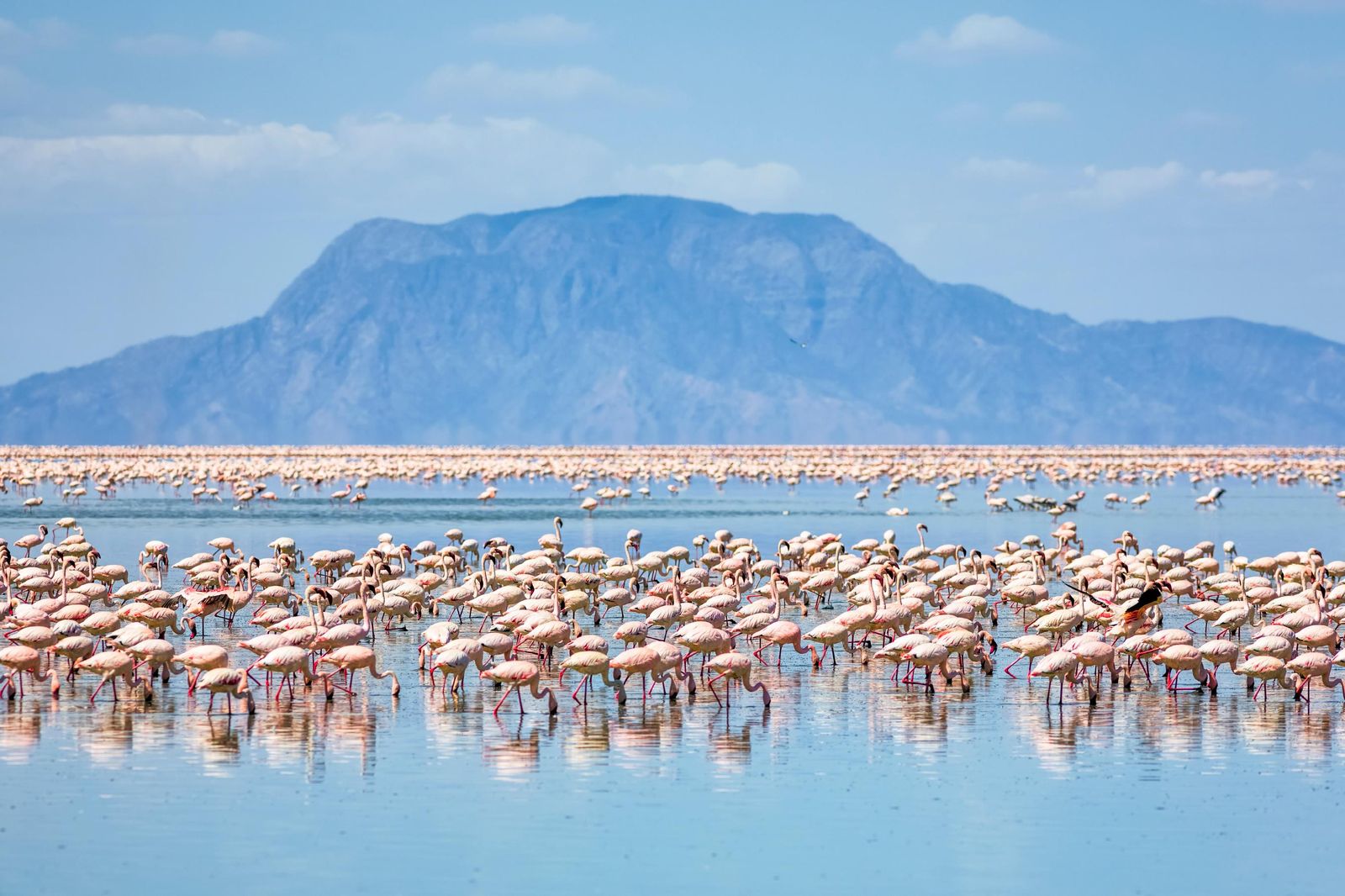Lake Natron, known for its caustic waters and vivid red hue, is the unlikely sanctuary for millions of lesser flamingos. The lake’s salt flats create optimal conditions for the growth of cyanobacteria—food source for the flamingos. Despite the inhospitable environment, this unique habitat is crucial to the survival of the flamingo population.
A significant aspect of Lake Natron’s story is its historical significance as a breeding ground for flamingos. Over 75% of the world’s lesser flamingos are born here, highlighting its importance. The lake’s harsh conditions deter predators, making it a vital haven for flamingo chicks during breeding season.

The Vital Ecosystem of Lake Natron
Lake Natron’s unique ecosystem is defined by its extreme conditions. The water is highly alkaline due to the presence of sodium carbonate and other minerals. This creates an environment where few life forms can thrive, yet it supports large populations of lesser flamingos.
The lake’s striking red color comes from the salt-loving organisms and algae that thrive in its harsh waters. It is a visual masterpiece, setting the stage for various life forms. Despite its seemingly hostile nature, it provides essential nutrients for the flamingos.
Interestingly, Lake Natron serves as a breeding ground for millions of lesser flamingos. The alkalinity of the water helps reduce predators, safeguarding the delicate nests. This makes it one of the most critical habitats for these birds.
Environmental threats like pollution and climate change pose risks to Lake Natron’s stability. Conservation efforts are crucial to preserve its unique environment. Action needs to be taken to maintain this vital ecosystem for flamingos and other species that rely on it.
Exploring the Unique Chemistry and Biological Significance
Lake Natron’s high alkalinity comes from its chemical composition, primarily due to sodium carbonate. This unusual environment supports specialized microorganisms, including cyanobacteria. These microorganisms give the lake its distinctive reddish-brown color.
The algae thriving in the lake form the primary food source for flamingos. They can withstand the extreme conditions that few other species can survive. In turn, this creates a unique food chain that is both fascinating and essential.
Flamingo nesting at Lake Natron depends on its uniquely caustic waters. The flamingos build their nests on small, isolated islands formed by salts. These nests are protected from typical predators due to the lake’s harsh conditions.
Lake Natron’s ecosystem is a vital habitat for diverse life forms. This includes not just the famous flamingos, but also bacteria and algae. Together, they create a delicate balance that is crucial for maintaining biodiversity.
The Role of Lake Natron in Flamingo Breeding
Lake Natron serves as an essential breeding ground for lesser flamingos. During the breeding season, flamingos flock to the lake to build nests on salt islands. These islands, formed from minerals and salts, provide a safe haven away from predators.
The extreme alkalinity of Lake Natron’s waters deters most natural threats. This unique condition helps to protect flamingo eggs and chicks. It ensures a higher survival rate compared to other habitats.
The nesting process at Lake Natron is truly remarkable. Flamingos create their nests from mud and saline deposits, elevating them above the water. This keeps the eggs dry and safe from flooding.
The lake’s ecosystem is critical for the growth of young flamingos. The ample supply of algae and cyanobacteria provides vital nutrients. Growing chicks consume this rich food to develop strong and healthy.
Conservation Efforts and the Future of Lake Natron
Lake Natron faces several environmental threats, including pollution and climate change. These threats jeopardize the delicate ecosystem that supports flamingos. Protecting this unique habitat requires urgent attention and action.
Conservation efforts are underway to protect Lake Natron and its wildlife. Organizations are working to reduce pollution and monitor water quality. These initiatives aim to sustain the habitat and ensure a safe breeding ground for flamingos.
Community engagement plays a crucial role in conservation efforts. Locals are educated about the importance of preserving Lake Natron. This helps build support for environmental initiatives and sustainable practices.
Policy changes at national and international levels can also safeguard the lake. Enforcing regulations to limit industrial pollutants is essential. Collaborative efforts between governments can fortify these measures.
Technological advancements offer new ways to monitor the lake’s health. Using drones and satellites to track water quality and wildlife populations is becoming more common. These tools enable quick responses to emerging threats.
The future of Lake Natron depends on continued conservation efforts. Protecting this vital ecosystem ensures the survival of the flamingo population. Sustained commitment is essential to preserving this unique natural wonder.


